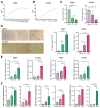Replicative Senescence-Associated LINE1 Methylation and LINE1-Alu Expression Levels in Human Endothelial Cells
- PMID: 36497059
- PMCID: PMC9739197
- DOI: 10.3390/cells11233799
Replicative Senescence-Associated LINE1 Methylation and LINE1-Alu Expression Levels in Human Endothelial Cells
Abstract
One of the main challenges of current research on aging is to identify the complex epigenetic mechanisms involved in the acquisition of the cellular senescent phenotype. Despite some evidence suggested that epigenetic changes of DNA repetitive elements, including transposable elements (TE) sequences, are associated with replicative senescence of fibroblasts, data on different types of cells are scarce. We previously analysed genome-wide DNA methylation of young and replicative senescent human endothelial cells (HUVECs), highlighting increased levels of demethylated sequences in senescent cells. Here, we aligned the most significantly demethylated single CpG sites to the reference genome and annotated their localization inside TE sequences and found a significant hypomethylation of sequences belonging to the Long-Interspersed Element-1 (LINE-1 or L1) subfamilies L1M, L1P, and L1HS. To verify the hypothesis that L1 demethylation could be associated with increased transcription/activation of L1s and/or Alu elements (non-autonomous retroelements that usually depend on L1 sequences for reverse transcription and retrotransposition), we quantified the RNA expression levels of both L1 (generic L1 elements or site-specific L1PA2 on chromosome 14) and Alu elements in young and senescent HUVECs and human dermal fibroblasts (NHDFs). The RNA expression of Alu and L1 sequences was significantly increased in both senescent HUVECs and NHDFs, whereas the RNA transcript of L1PA2 on chromosome 14 was not significantly modulated in senescent cells. Moreover, we found an increased amount of TE DNA copies in the cytoplasm of senescent HUVECs and NHDFs. Our results support the hypothesis that TE, which are significantly increased in senescent cells, could be retrotranscribed to DNA sequences.
Keywords: Alu sequences; LINE1; cellular senescence; retrotransposable elements.
Conflict of interest statement
The authors declare no conflict of interest.
Figures





Similar articles
-
Molecular reconstruction of extinct LINE-1 elements and their interaction with nonautonomous elements.Mol Biol Evol. 2013 Jan;30(1):88-99. doi: 10.1093/molbev/mss202. Epub 2012 Aug 23. Mol Biol Evol. 2013. PMID: 22918960 Free PMC article.
-
Global DNA hypomethylation of Alu and LINE-1 transposable elements as an epigenetic biomarker of anti-tuberculosis drug-induced liver injury.Emerg Microbes Infect. 2021 Dec;10(1):1862-1872. doi: 10.1080/22221751.2021.1976079. Emerg Microbes Infect. 2021. PMID: 34467830 Free PMC article.
-
Epigenetic control of retrotransposon expression in human embryonic stem cells.Mol Cell Biol. 2011 Jan;31(2):300-16. doi: 10.1128/MCB.00561-10. Epub 2010 Nov 1. Mol Cell Biol. 2011. PMID: 21041477 Free PMC article.
-
The epigenetic alterations of endogenous retroelements in aging.Mech Ageing Dev. 2018 Sep;174:30-46. doi: 10.1016/j.mad.2018.02.002. Epub 2018 Feb 16. Mech Ageing Dev. 2018. PMID: 29458070 Review.
-
Long interspersed nuclear element 1 and B1/Alu repeats blueprint genome compartmentalization.Curr Opin Genet Dev. 2023 Jun;80:102049. doi: 10.1016/j.gde.2023.102049. Epub 2023 May 23. Curr Opin Genet Dev. 2023. PMID: 37229928 Review.
Cited by
-
The transcription factor PAX5 activates human LINE1 retrotransposons to induce cellular senescence.EMBO Rep. 2024 Aug;25(8):3263-3275. doi: 10.1038/s44319-024-00176-9. Epub 2024 Jun 12. EMBO Rep. 2024. PMID: 38866979 Free PMC article.
-
Reactivation of retrotransposable elements is associated with environmental stress and ageing.Nat Rev Genet. 2025 Aug;26(8):547-558. doi: 10.1038/s41576-025-00829-y. Epub 2025 Apr 2. Nat Rev Genet. 2025. PMID: 40175591 Review.
-
Therapy-Induced Cellular Senescence: Potentiating Tumor Elimination or Driving Cancer Resistance and Recurrence?Cells. 2024 Jul 30;13(15):1281. doi: 10.3390/cells13151281. Cells. 2024. PMID: 39120312 Free PMC article. Review.
-
Replicative senescence and high glucose induce the accrual of self-derived cytosolic nucleic acids in human endothelial cells.Cell Death Discov. 2024 Apr 20;10(1):184. doi: 10.1038/s41420-024-01954-z. Cell Death Discov. 2024. PMID: 38643201 Free PMC article.
References
MeSH terms
Substances
Grants and funding
LinkOut - more resources
Full Text Sources

